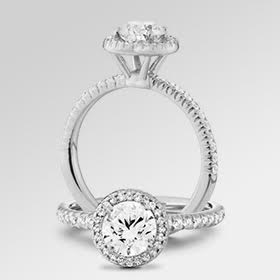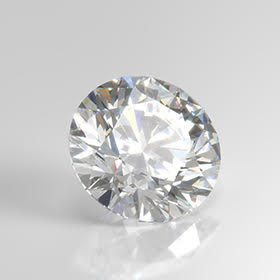Hi, conscious consumers — this blog is for you. It’s also for those of you who are just beginning to research the differences in mined and lab-grown diamonds. While much of the debate about lab-grown diamonds zeroes in on semantics (like suggesting lab-grown diamonds aren’t “real”, which is totally false), there are plenty of tangible benefits to opting for a diamond born in a lab versus a diamond formed in the Earth. You probably already know some of these benefits, like how much more affordable lab-grown diamonds are, but today we’re shining the spotlight on the category of ethics. From human capital to the environment through to your personal investment, everything about lab-grown diamonds is more ethical than mined diamonds. In this blog, we’ll take a deep dive into the five main ethical advantages of lab-created diamonds.
- Lab-grown diamonds are the only true conflict-free diamonds.
Think that mined diamonds with a Kimberley certificate aren’t blood diamonds? Think again. There is a lot of history and explaining to do here, but we’ll try to summarize this sad legacy of mined diamonds as succinctly as possible.
Blood diamonds, which are also known as conflict diamonds, came into the worldwide spotlight in the 1990s, as many African countries in the diamond industry (Angola, Democratic Republic of Congo, Ivory Coast, Liberia, and Sierra Leone) came under scrutiny for the irregulated trade of diamonds and worse yet, for the funding those diamonds provided. Civil wars had erupted across these countries, and the blood diamonds were providing financial and physical resources for the rebel militias. With civil wars comes chaos and horrific crimes against citizens. Consider this information from Stanford University:
Sierra Leone has suffered terrible social and economic costs as a result of its civil war and fight over diamond control. Under the cover of warfare, the rebels committed heinous crimes against humanity in the form of murder, rape, and mutilation. The war between 1991 and 1999 claimed over 75,000 lives, caused 500,000 Sierra Leoneans to become refugees, and displaced half of the country’s 4.5 million people. Also, during this period, the Sierra Leone economy was being cheated out of millions of dollars in the form of illegal diamonds.
In order to try to stop these horrible things, the UN formed a coalition of 54 countries from around the world to help stop blood diamonds from entering the market. This coalition is now known as the Kimberley Process. From its website: “The Kimberley Process (KP) is a multilateral trade regime established in 2003 with the goal of preventing the flow of conflict diamonds. The core of this regime is the Kimberley Process Certification Scheme (KPCS) under which States implement safeguards on shipments of rough diamonds and certify them as ‘conflict-free’".
Problem solved, right? Wrong. Although the KP has, without a doubt, been helpful in imposing tighter regulations to cut back on blood diamonds, it’s not fail-proof and has been widely criticized. This excerpt from The Guardian perfectly summarizes the main flaws:
The process has two main flaws. First, its narrow terms of certification focus solely on the mining and distribution of conflict diamonds, meaning that broader issues around worker exploitation - the health and safety of working conditions, the use of child labour and fair pay – are not addressed. It also fails to deal with entire populations being evicted from their ancestral homes to make way for mining.
Second, a Kimberley Process certificate does not apply to an individual stone but to a batch of rough diamonds which are then cut and shipped around the world. Without a tracking system, this is where the trail ends.
So, there you have it. If you’re interested in a broad view of ethics that includes issues like child labor and worker safety, the Kimberley Process is no help. And, the lack of a tracking system leaves questions around the journey of a diamond before it’s set in an engagement ring. Therefore, the only true way to know that you’re investing in a conflict-free diamond is by purchasing a lab-grown diamond. You can have peace of mind knowing that at New World Diamonds, we only use ethical diamonds in our engagement rings and other jewelry. Furthermore, every diamond sold from New World Diamonds originated in a laboratory in the United States that we own. We can vouch that our scientists are treated well and that our lab offers a safe, controlled environment to make beautiful, ethical diamonds. That’s a much better origin story of your diamond to talk about with your friends, agree?
- Lab-grown diamonds help with the issue of child labor.
Now that you know all about conflict diamonds (and all the gray area that still exists), you surely are saddened by how unethical the mining industry is. And unfortunately, it gets worse.
Because of widespread income inequality and basic desperation to survive among those most impoverished, children are often viewed as a source of cheap labor in the mining industry. An estimated 215 million children are working in exploitative conditions, and of that 115 million are working in hazardous conditions like mines. Additionally, over 32,000 children die from hazardous working conditions each year (source). Children are often tasked with the most difficult jobs, like entering narrow mineshafts or descending into pits, because of their small size. They work grueling hours, six to seven days each week, and therefore cannot go to school. Of course, this sets them up for a strained adulthood, because their bodies become physically handicapped thanks to this difficult work, and their lack of education keeps them from obtaining another job.
It doesn’t stop at the mines, either. Sadly, children are also heavily recruited to work in cutting and polishing factories in India. They are believed to have better eyesight and fine motor skills than adult laborers, and therefore the most vulnerable among them are forced into labor at a very young age. We wrote more about these issues here.
We completely condemn this exploitation in the mining industry and are saddened that we have to report conditions like this. However, there is power in sharing the truth, and there is a solution in lab-grown diamonds. In buying lab-grown diamonds, you never have to wonder if a child suffered in order to create your engagement ring or polish your diamond.
- Workers are underpaid and exploited in the mining industry.
Nearly 15% of mined diamonds come from small-scale mining operations, which are wrought with hazardous working conditions and offer up extremely low pay. Wondering how this is possible? The small-scale operations simply are not regulated, so there are no real labor laws and certainly no governing bodies to enforce them. It’s been reported that an estimated one million diamond diggers earn less than $1 daily, which puts their very survival at risk (source).
In addition to being grossly underpaid, these diamond workers also work in very unsafe conditions. Since it’s unregulated, they do not have the proper tools or personal protective equipment (PPE) to help them stay safe. Because the work is carried out without the proper equipment, this makes the workers vulnerable to disasters, like being involved in a mine collapse. Furthermore, they are at risk of being caught by more powerful groups who want to control the mining trade. It’s not unusual for these small-scale artisanal workers to be beaten or even shot if they are caught doing illegal work.
There is a clear advantage to buying lab-grown diamonds with regard to worker exploitation and unsafe conditions.
- Lab-grown diamonds are more sustainable.
When it comes to sustainability, there are several things to address. Let’s start with what is required from Earth in order to mine diamonds. Did you know that in order to find just one carat of diamond, approximately 200 to 250 tons of Earth must be sifted through? Heavy machinery is required for these tasks, which causes a tremendous amount of fossil fuel to be released into the environment. Not to mention, diamond mines cause HUGE holes to be left in the middle of communities!
Let’s briefly consider the Mirny Mine, sometimes called the Mir Mine, located in Eastern Siberia. Abandoned since 2004, this massive hole spans nearly a mile in diameter and is 1,722’ deep! This is absolutely astounding to consider that we are destroying such enormous amounts of land in hopes of finding gemstones — when we now have the technology to grow ethical diamonds in a controlled environment!
Furthermore, we should point out that diamond mining is becoming less sustainable each year. One of the reasons for this is that nearly all of the diamonds have been extracted from the Earth’s core, but another reason is where diamonds are being mined. Because so many diamonds have been mined from the most famous kimberlite pipes in Africa, the mining efforts are now shifting to extremely cold arctic areas in Canada and Russia. As you can imagine, this requires a lot more energy to extract.
We also should talk about what kind of energy is required to create diamonds in the lab, as many of familiar with sustainability may be wondering if this is a hidden con in lab-created diamonds. Fair enough, the process of creating diamonds in the lab used to be MUCH more carbon intensive than it is today, thanks to advances in technology and the new creation process known as Chemical Vapor Distillation (CVD), which is much less energy-intensive than the old methods of using high pressure and high temperature. Still yet, there is data to back up claims about sustainability. Consider this excerpt from a Guardian article on diamond sustainability:
One Stanford University graduate was able to carry out research comparing the energy intensity of mined diamonds at BHP Billiton's Ekati mine in Canada against the lab-created diamonds produced by Gemesis in the US. According to the research, Gemesis' lab-grown diamonds produced less than one-fifth of the carbon dioxide emissions that result from diamond mining at Ekati. Extrapolating this out, the paper claimed that replacing the Ekati mine's annual diamond production with lab-grown diamonds would save the equivalent of around 483m miles' worth of auto emissions.
- There isn’t much price markup on lab-grown diamonds.
It’s time to talk about your personal ethics. While we’ve mostly been talking about the lack of ethics for others, as well as for Earth, in the diamond mining industry, we also need to mention that you, as the consumer, are being taken advantage of by the mining industry. Earth-formed diamonds are marked up 100% or more, and there’s a long sketchy history about how the De Beers corporation monopolized the industry and then created deceptive ads in order to make people believe that the bigger the diamond, the greater the love. (We wrote an entire blog about this that debunks the myth that diamonds are rare; read it here)
On the other hand, lab-grown diamonds are much more affordable not because of huge supply-chain discrepancies, but because they don’t come with a ridiculous markup! When you pay for a lab-grown diamond, you are paying for its creation process in the lab, and that’s it. At New World Diamonds, we offer the lowest priced diamonds across the mined and lab-grown realms, because we own our very own laboratory where we grow diamonds. So basically, we get to keep our prices even lower because we own the entire supply chain and don’t work with middlemen. You can compare our prices to other lab-grown diamond brands here.
Do you feel fully informed on ethical diamonds and all that the topic encompasses? We hope so! It’s our goal to remain transparent and share our values for people and the environment while we educate people about the differences in Earth-formed and lab-grown diamonds. Whether you are shopping for loose stones to add to existing jewelry, engagement rings, a halo pendant, or diamond stud earrings, we have ethical diamonds for everyone. Treat yourself to something sparkly and beautiful, without the guilt. Shop now









